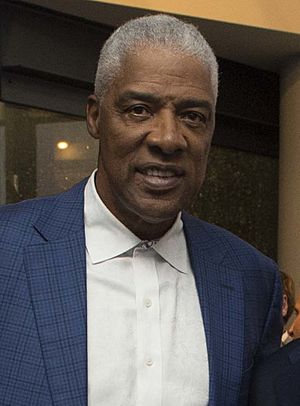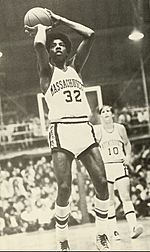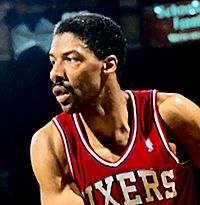Julius Erving facts for kids

Erving in 2016
|
|
| Personal information | |
|---|---|
| Born | February 22, 1950 East Meadow, New York, U.S. |
| High school | Roosevelt (Roosevelt, New York) |
| Listed height | 6 ft 7 in (2.01 m) |
| Listed weight | 200 lb (91 kg) |
| Career information | |
| College | UMass (1969–1971) |
| NBA Draft | 1972 / Round: 1 / Pick: 12th overall |
| Selected by the Milwaukee Bucks | |
| Pro career | 1971–1987 |
| Career history | |
| 1971–1973 | Virginia Squires |
| 1973–1976 | New York Nets |
| 1976–1987 | Philadelphia 76ers |
| Career highlights and awards | |
|
|
| Career ABA and NBA statistics | |
| Points | 30,026 (24.2 ppg) |
| Rebounds | 10,525 (8.5 rpg) |
| Assists | 5,176 (4.2 apg) |
Julius Winfield Erving II (born February 22, 1950), known as Dr. J, is a famous American basketball player. He was a superstar in the American Basketball Association (ABA). He helped make the ABA popular before it joined with the National Basketball Association (NBA) in 1976.
Dr. J won many awards. He earned three championships and four Most Valuable Player (MVP) awards. He also won three scoring titles. His teams, the Virginia Squires, New York Nets, and Philadelphia 76ers, always made it to the playoffs. He is the eighth-highest scorer in ABA/NBA history. He scored over 30,000 points in total. Dr. J was famous for his amazing slam dunks. He could even dunk from the free-throw line! He is the only player to be named MVP in both the ABA and NBA. The term "posterized" was first used to describe his incredible moves.
Julius Erving is considered one of the most talented players ever. Many people think he is the best dunker of all time. Before Dr. J, dunking was mostly done by tall players close to the basket. It was seen as just showing off. But Dr. J changed that. He made the dunk an artistic and effective shot. He often started his dunks far from the basket. He showed that dunks could be graceful and powerful.
Contents
Early Life & the "Dr. J" Nickname
Julius Erving was born on February 22, 1950. He grew up in East Meadow, New York, and later in Roosevelt, New York. He played basketball for Roosevelt High School. He got his famous nickname "Doctor" or "Dr. J" from a high school friend, Leon Saunders.
Erving later played in the Rucker Park league in Harlem. People there called him "Black Moses" and "Houdini." But he told them, "If you want to call me anything, call me 'Doctor'." Over time, it became "Dr. Julius" and then "Dr. J." His friend and future teammate, Willie Sojourner, was the first to call him "Dr. J."
College Basketball Career
Erving went to the University of Massachusetts Amherst in 1968. In his two years playing college basketball, he averaged 26.3 points and 20.2 rebounds per game. He was one of only six players in NCAA Men's Basketball history to average more than 20 points and 20 rebounds. The NCAA had a rule against dunking in 1968. So, only his teammates saw his amazing dunks in practice.
Years later, Erving kept a promise to his mother. He earned a bachelor's degree from UMass in 1986. He also has an honorary doctorate from the university. In September 2021, UMass honored Erving with a statue outside the Mullins Center.
In 1970, Erving played for the U.S. Olympic Development Team. He hoped to join the 1972 Summer Olympics team. He was a top rebounder and scorer for Team USA. He played against professional players from other countries. During this time, he learned about the American Basketball Association (ABA). The ABA wanted to sign college players. Erving decided to join the ABA in late 1971.
Professional Basketball Journey
Virginia Squires (1971–1973)
NBA rules did not allow teams to draft players who were less than four years out of high school. But the ABA had a "hardship" rule. This rule let players leave college early. Erving used this rule and left UMass after his junior year. He signed a four-year contract with the Virginia Squires.
Erving quickly became a star. He was known for his powerful dunks. As a rookie, he scored 27.3 points per game. He was named to the All-ABA Second Team and the ABA All-Rookie Team. He led the Squires to the Eastern Division Finals. They lost to the New York Nets in seven games.
Moving to the New York Nets (1973–1976)
The Virginia Squires had money problems. They sold Erving's contract to the New York Nets. This was a complicated deal that kept him in the ABA. Erving signed an eight-year deal with the Nets. The Squires received money and other players. The Nets also paid the Atlanta Hawks to settle a dispute over Erving's NBA rights.
Erving led the Nets to their first ABA title in 1974. They beat the Utah Stars. Erving became the most important player in the ABA. His exciting play made the Nets a top team. He also brought many fans and respect to the league.
The ABA and NBA finally merged after the 1975–76 season. The Nets and Denver Nuggets had already applied to join the NBA. Erving led the Nets to victory over the Nuggets in the ABA's final championship. He averaged 34.7 points in the playoffs and was named MVP. That season, he was a top player in many categories. This was the only season in either league where a player achieved such a feat.
Philadelphia 76ers (1976–1987)
The Nets, Nuggets, Indiana Pacers, and San Antonio Spurs joined the NBA for the 1976–77 season. The New York Knicks demanded that the Nets pay them a large fee for joining their territory. Because of these fees, the Nets' owner could not keep his promise to raise Erving's salary. Erving refused to play under these conditions.
The Philadelphia 76ers then offered to buy Erving's contract for $3 million. The Nets had no choice but to accept. This deal left the Nets struggling. They traded their best player just to join the NBA.
Erving wanted to wear his old No. 32 jersey. But it was retired for Billy Cunningham. So, he chose No. 6 to honor his hero, Bill Russell. Erving quickly became the leader of the 76ers. He led them to a great 50-win season. He played with other stars like George McGinnis and Doug Collins. This allowed him to focus on team play. The 76ers won their division and were very popular. They reached the 1977 NBA Finals but lost to the Portland Trail Blazers.
Erving also found success off the court. He was one of the first basketball players to endorse many products. He even had a shoe named after him. He also appeared in the 1979 basketball comedy movie, The Fish That Saved Pittsburgh. Over the next few years, the 76ers built a stronger team around Erving. Coach Billy Cunningham and players like Maurice Cheeks and Bobby Jones joined the team.
The 76ers faced tough competition. In 1979, Larry Bird joined the league, making the Boston Celtics a strong rival. The Bird vs. Erving matchup became a top rivalry in basketball. In 1980, the 76ers reached the 1980 NBA Finals against the Los Angeles Lakers. Erving performed his famous "Baseline Move," an incredible reverse layup. The Lakers won the series. Erving also made the only three-point shot in that Finals. It was the first time the three-point line was used in the league.
Erving continued to be one of the best players. But the 76ers faced more playoff disappointments. In 1981, the Celtics beat them in seven games. In 1982, the 76ers beat the Celtics but lost to the Lakers in the NBA Finals. Despite these losses, Erving was named the NBA MVP in 1981.
For the 1982–83 season, the 76ers added Moses Malone. With Erving and Malone, the 76ers dominated the season. Malone famously predicted "fo-fo-fo" for the playoffs, meaning they would sweep all three rounds. The 76ers actually went four-five-four. They lost one game to the Milwaukee Bucks but then swept the Lakers to win the NBA title.
Erving remained an All-Star player in his later years. He announced his retirement in 1986. In his final season, opposing teams honored him in his last games in their arenas.
Retirement and Legacy
Erving retired in 1987 at age 37. Johnny Kerr said, "A young Julius Erving was like Thomas Edison, he was always inventing something new every night." His jersey numbers have been retired by two teams. The Brooklyn Nets (formerly New York Nets) retired his No. 32. The Philadelphia 76ers retired his No. 6. He was a great all-around player and an excellent defender. In his ABA days, he guarded the best forwards. He was also a top passer, ball handler, and scorer. Many of his amazing plays were not widely seen due to limited TV coverage in the ABA. He is widely considered the greatest dunker of all time.
In his combined ABA and NBA careers, he scored over 30,000 points. In 1993, Erving was inducted into the Naismith Memorial Basketball Hall of Fame. He also joined the NYC Basketball Hall of Fame in 1996. When he retired, Erving was among the top players in scoring, field goals, and steals. As of 2025, Erving ranks eighth on the combined NBA/ABA scoring list.
Memorable Moments
1976 ABA Slam Dunk Contest
In this famous contest, Erving competed against George "The Iceman" Gervin and others. Erving started by dunking two balls. Then, he performed a move that made the slam dunk contest famous. He ran from the opposite end of the court and dunked the basketball from the free-throw line. Other players had done this before, but Erving showed it to a much wider audience. He performed this feat in the 1976 ABA All-Star Game Slam Dunk Contest.
Dunk Over Bill Walton
This amazing dunk happened during Game 6 of the 1977 NBA Finals. After Portland scored, Erving ran the full length of the court. He dribbled past several defenders. Then, with Bill Walton waiting, Erving threw down a powerful slam dunk over Walton. Many consider this one of the strongest dunks ever. He ran the whole court with all five defenders chasing him. This dunk was a highlight of his arrival in the NBA, which had more TV coverage.
The "Baseline Move"
One of his most famous plays happened during the 1980 NBA Finals. He made an almost impossible finger-roll layup from behind the backboard. He drove past a Lakers player on the right side. Then, 7-foot-2 center Kareem Abdul-Jabbar blocked his path. Erving was in mid-air and seemed to be landing behind the backboard. But he somehow reached over and scored with a right-handed layup. His whole body was already behind the hoop. This move, along with his free-throw line dunk, is a signature moment of his career. Sports Illustrated called it "The, No Way, even for Dr. J, Flying Reverse Lay-up." Dr. J simply called it "just another move."
"Rock the Baby" Dunk
Another memorable play came in 1983 against the Los Angeles Lakers. After a steal, Erving got the ball and charged down the court. He faced Michael Cooper, the Lakers' top defender. As he got close to the basket, he held the ball in his wrist and forearm. He rocked the ball back and forth. Then he took off for a "Rock the Baby" slam dunk. He swung the ball behind his head and dunked over Cooper. This dunk is often called one of the greatest dunks of all time.
Life After Basketball
Erving earned his bachelor's degree in 1986. After his basketball career, he became a businessman. He owned a Coca-Cola bottling plant in Philadelphia. He also worked as a television analyst. In 1997, he joined the Orlando Magic front office.
Erving and former NFL player Joe Washington owned a NASCAR team from 1998 to 2000. They were the first NASCAR team owned entirely by minorities. Erving, a racing fan, wanted to increase interest in NASCAR among African-Americans. He also served on the boards of several companies. In 2009, Erving owned a golf club near Atlanta.
In 1991, he narrated a performance of Copland's Lincoln Portrait with the Philadelphia Orchestra. He also made cameo appearances in movies and TV shows. These included the 1993 movie Philadelphia and the sitcom Hangin' with Mr. Cooper. He appeared in the 2012 remake of Steel Magnolias and an episode of The Office in 2013. In 2022, Erving appeared as himself in the movie Hustle.
Awards and Honors
Halls of Fame
- Naismith Memorial Basketball Hall of Fame – Class of 1993
- National Collegiate Basketball Hall of Fame – Inaugural Class of 2006
- NYC Basketball Hall of Fame – Class of 1996
- University of Massachusetts Athletics Hall of Fame – Class of 1980
- Long Island Sports Hall of Fame – Inaugural Class of 1984
NBA
- NBA champion (1983)
- NBA Most Valuable Player (1981)
- 2× ABA champion (1974, 1976)
- 2× ABA Playoffs MVP (1974, 1976)
- 3× ABA Most Valuable Player (1974–1976)
- 11× NBA All-Star (1977–1987)
- 5× ABA All-Star (1972–1976)
- 2× NBA All-Star Game MVP (1977, 1983)
- 5× All-NBA First Team (1978, 1980–1983)
- 2× All-NBA Second Team (1977, 1984)
- 4× All-ABA First Team (1973–1976)
- All-ABA Second Team (1972)
- ABA All-Defensive First Team (1976)
- ABA All-Rookie First Team (1972)
- 3× ABA scoring champion (1973, 1974, 1976)
- ABA Slam Dunk champion (1976)
- 3× NBA Player of the Month
- 3× NBA Player of the Week (inaugural winner)
- ABA All-Time Team
- ABA All-time MVP
- NBA anniversary team (35th, 50th, 75th)
- No. 32 retired by Brooklyn Nets
- No. 6 retired by Philadelphia 76ers
- J. Walter Kennedy Citizenship Award (1983)
- Statue of Julius Erving outside the Philadelphia 76ers Training Complex (2018)
- In 2023, the NBA named the Slam Dunk Contest champion trophy in his honor
NCAA
- 2× Yankee Conference Champion (1970, 1971)
- UPI Third-team All-American (1971)
- NABC Third-team All-American (1971)
- AP All-American Honorable Mention (1971)
- No. 32 retired by UMass Minutemen
- The Julius Erving Award is given annually to the top men's collegiate small forward
- Statue of Julius Erving outside the Mullins Center (2021)
Media
- 2× Metropolitan Basketball Writers Association Outstanding ABA Player of the Year (1974, 1975)
- Sporting News NBA MVP (1981)
- Sporting News NBA/ABA 1970s All-Decade First Team
- Sporting News NBA 1980s All-Decade First Team
- AP NBA 1980s All-Decade Team
- Sports Illustrated's 40 Most Influential Sports Figures (1994)
- Academy of Achievement Golden Plate Award (1988)
- Harold & Carole Pump Foundation – Lifetime Achievement Award (2012)
- Nancy Lieberman Charities – Trailblazer Award (2019)
Other
- In 2018, the BIG3 named their championship trophy in honor of Dr. J
Community Art
The Dr. J mural is located in Philadelphia, PA. It is on the corner of Green Street and Ridge Avenue. This mural was created by artist Kent Twitchell. He wanted to show Julius Erving as a role model, not just an athlete. The mural shows a dignified, full-length portrait of Erving in a business suit. It is so tall that Erving's head fits just under the top of the three-story building.
The mural was painted on large pieces of parachute cloth. These were then attached to the wall. This method allowed for very realistic details. Local residents say that the real Dr. J cried when he first saw the completed portrait. The mural was highly praised. It showed that murals could be great works of art. It also helped change public opinion about the mural program.
Images for kids
See also
 In Spanish: Julius Erving para niños
In Spanish: Julius Erving para niños






